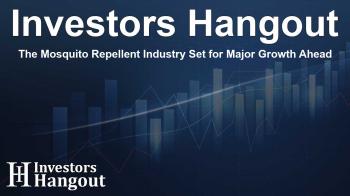The Mosquito Repellent Industry Set for Major Growth Ahead

Mosquito Repellent Market Overview
The global mosquito repellent market is on track to hit USD 11.64 billion by the end of the forecast period, exhibiting a compound annual growth rate (CAGR) of 5.58%. This surge is significantly influenced by an uptick in vector-borne diseases and an increase in outdoor activities among consumers.
Driving Factors Behind Market Growth
One of the primary drivers for the growth of the mosquito repellent market is the shift towards innovation-based formulations. Consumers are increasingly favoring DEET-free, natural, and skin-friendly mosquito repellents. These products not only prevent bites effectively but also address growing environmental and health concerns. Urbanization paired with rising disposable incomes in developing regions further bolsters this market. Regulatory support from bodies like the U.S. Environmental Protection Agency ensures the continuous development of new ingredients, prompting companies to innovate their safety and efficacy.
North America: Leading the Charge
Within the region, the United States leads the mosquito repellent market, valued at approximately USD 1.08 billion in 2023 and expected to grow to USD 1.87 billion by 2032. The increasing recognition of the dangers posed by mosquito-borne diseases, combined with heightened outdoor activity such as camping and hiking, drives this growth forward. Initiatives from public health organizations, including the Centers for Disease Control and Prevention, further promote the usage of repellents across urban and suburban environments.
Key Players in the Industry
Several companies dominate the mosquito repellent space, leveraging their strong market presence to drive innovation and growth. Key players include SC Johnson, Reckitt Benckiser, Godrej Consumer Products, Spectrum Brands, and BASF, among others. These companies continue to introduce new products while maintaining a focus on sustainability and natural ingredients.
Market Segmentation Insights
When dissecting the mosquito repellent market, it’s evident that various segments target different consumer needs and preferences. Notably, coil repellents captured around 32% of the total market share in 2023 due to their affordability, especially in budget-conscious households who face the risk of diseases like malaria and dengue.
By Repellent Type
Coils remain prevalent because of their cost-effective nature. Improvements in coil formulations, such as long-lasting and low-smoke varieties, contribute to their continued popularity. Additionally, the lotion segment holds more than 38% of the total market share, favored for its convenience and effectiveness, particularly in warm climates.
By Distribution Channel
The distribution channels for mosquito repellents are varied, with supermarkets and hypermarkets capturing around 45% of the market in 2023. The accessibility of various brands and enticing discounts makes these outlets popular among consumers. However, e-commerce channels are rapidly gaining traction, providing convenience through home delivery and subscriptions.
Regional Market Dynamics
The Asia-Pacific region boasts the largest share of the global market at roughly 42%. This growth can be attributed to countries like India and China, which grapple with high incidences of mosquito-related diseases and have implemented significant public health campaigns. Rising disposable incomes and the increasing presence of retail networks that offer branded mosquito repellents further accelerate market growth in the region.
Innovations and Recent Developments
Recently, notable product advancements have characterized the mosquito repellent landscape. For instance, SC Johnson launched a plant-based mosquito repellent in 2024 to appeal to eco-conscious consumers. Meanwhile, Godrej Consumer Products has undertaken efforts to introduce affordable options in rural areas, showing a commitment to meet the needs of all demographics.
Frequently Asked Questions
What factors are driving growth in the mosquito repellent market?
The growth is driven by an increase in outdoor activities, rising awareness of mosquito-borne diseases, and innovation in product formulations.
Which region dominates the mosquito repellent market?
The North American region, particularly the United States, currently leads the market.
What segments are showing significant growth in this market?
Coil repellents and lotion-based products show substantial market presence due to their effectiveness and consumer preferences.
Who are the leading companies in this market?
Major players include SC Johnson, Reckitt Benckiser, Godrej Consumer Products, and BASF among others.
How is the market expected to evolve in the coming years?
With continuous R&D and a focus on eco-friendly products, the market is poised for steady growth, reaching significant milestones by 2032.
About The Author
Contact Ryan Hughes privately here. Or send an email with ATTN: Ryan Hughes as the subject to contact@investorshangout.com.
About Investors Hangout
Investors Hangout is a leading online stock forum for financial discussion and learning, offering a wide range of free tools and resources. It draws in traders of all levels, who exchange market knowledge, investigate trading tactics, and keep an eye on industry developments in real time. Featuring financial articles, stock message boards, quotes, charts, company profiles, and live news updates. Through cooperative learning and a wealth of informational resources, it helps users from novices creating their first portfolios to experts honing their techniques. Join Investors Hangout today: https://investorshangout.com/
The content of this article is based on factual, publicly available information and does not represent legal, financial, or investment advice. Investors Hangout does not offer financial advice, and the author is not a licensed financial advisor. Consult a qualified advisor before making any financial or investment decisions based on this article. This article should not be considered advice to purchase, sell, or hold any securities or other investments. If any of the material provided here is inaccurate, please contact us for corrections.

